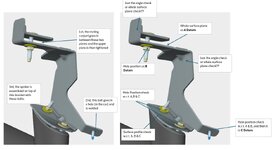MPSU
Automotive
- Aug 26, 2024
- 23
Hey everyone,
I'm a bit of a novice when it comes to GD&T. I can read drawings and figure out how to design a checking gauge based on the GD&T, but this is my first time being tasked with applying GD&T to a part. My boss has handed me a bracket that attaches to a car and supports the spoiler, and I'm looking for some advice.
I've attached a picture showing how the bracket assembles onto the car, along with my initial thoughts on the GD&T. Specifically, I'm looking for feedback on:
Looking forward to your thoughts!
I'm a bit of a novice when it comes to GD&T. I can read drawings and figure out how to design a checking gauge based on the GD&T, but this is my first time being tasked with applying GD&T to a part. My boss has handed me a bracket that attaches to a car and supports the spoiler, and I'm looking for some advice.
I've attached a picture showing how the bracket assembles onto the car, along with my initial thoughts on the GD&T. Specifically, I'm looking for feedback on:
- Does my Datum scheme make sense for this part and its function?
- Does my approach to checking the part seem practical?
Looking forward to your thoughts!

